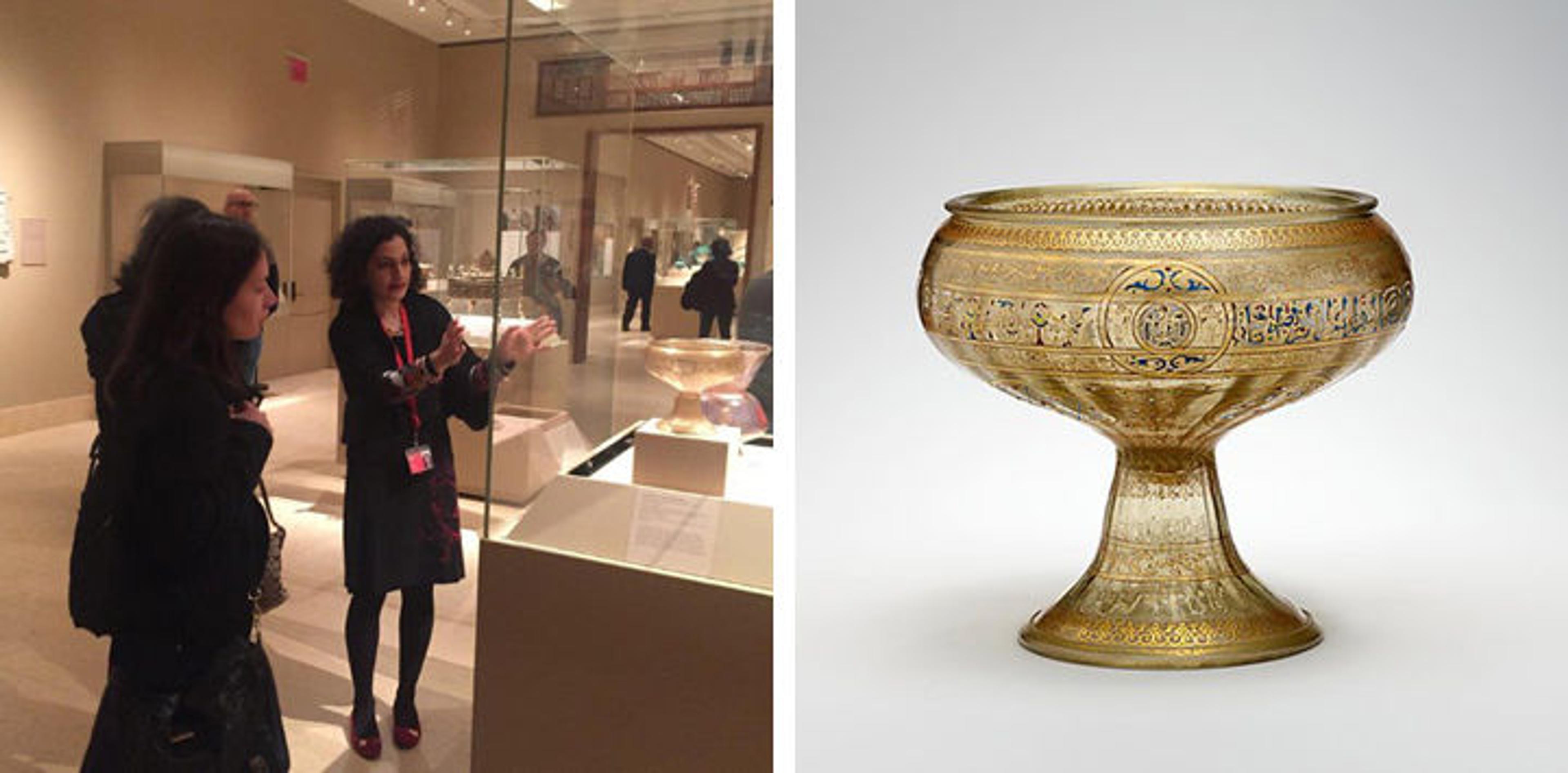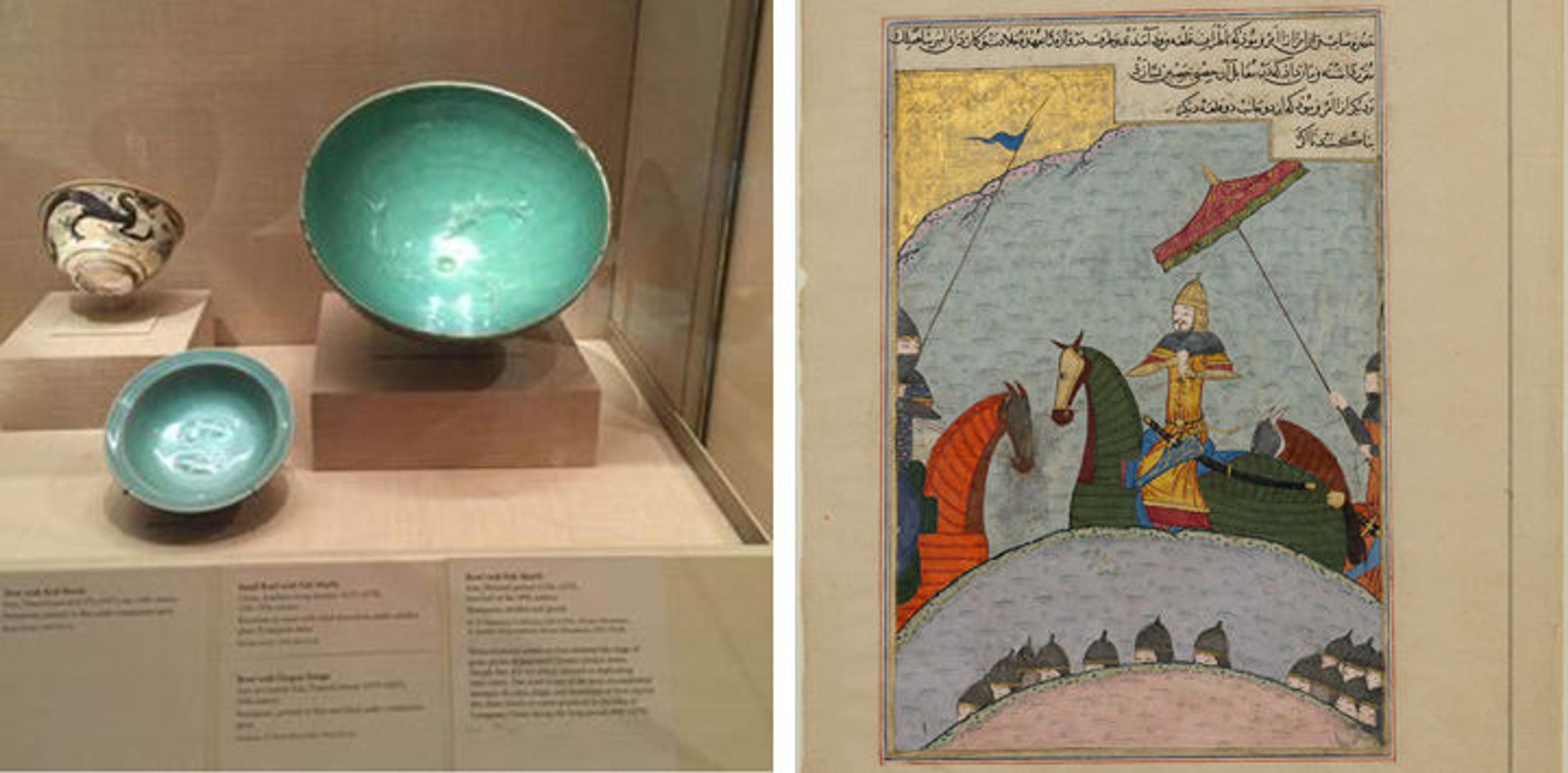
Sheila Canby discusses Mamluk enamel and gilding techniques in gallery 450. Photo by Kim Benzel
«Days before a Super Bowl audience watched New England Patriots quarterback Tom Brady rain a torrent of touchdowns on the unsuspecting Atlanta Falcons, The Met threw a clutch touchdown pass of its own. For two hours on Friday, February 3, the curators of the Departments of Islamic Art and Ancient Near Eastern Art teamed up to engage with the public in the Galleries for the Art of the Arab Lands, Turkey, Iran, Central Asia, and Later South Asia. At a time when misunderstanding of the region known today as the Middle East is so pervasive and consequential, The Met is working to build bridges via its diverse and exquisite collection. Focused on works of art from the lands that are now Iran, Iraq, Syria, and Yemen—four of the seven countries affected by the recent US travel ban—the curators sought to reach out and open a dialogue about Islamic and Ancient Near Eastern art and history.»

Left: Enameled and gilded bottle, late 13th century. Attributed to Egypt. Glass, greenish; blown, folded foot; enameled and gilded, H. 17 1/8 in. (43.5 cm), max. diam. 11 in. (27.9 cm). The Metropolitan Museum of Art, New York, Rogers Fund, 1941 (41.150)
As a curatorial fellow in the Department of Islamic Art, I joined the team in the first gallery, which houses some of the masterpieces of the collection. Here Sheila Canby, Patti Cadby Birch Curator in Charge of the department, described the technique of enameling and gilding glass to visitors, explaining how much practice was required before it could be mastered. Pointing to a large, meticulously decorated enameled and gilded glass bottle, Canby explained that Egypt and Syria were well-known centers for the production of enameled and gilded glass during the 13th and 14th centuries.

Left: In gallery 452, Assistant Curator Martina Rugiadi converses with a visitor about the artworks from Iran and Central Asia. Photo by Kim Benzel. Right: Painted dado panels, ca. 9th century. Excavated in Iran, Nishapur. Painted stucco, H. 40 3/8 in. (102.6 cm), W. 53 1/2 in. (135.9 cm), D. 2 in. (5.1 cm), Wt. 195 lbs (88.5 kg). The Metropolitan Museum of Art, New York, Rogers Fund, 1940 (40.170.176)
Moving on to gallery 451, I spoke about diverse and innovative artworks from the Umayyad and Abbasid caliphates of the seventh to thirteenth centuries (present-day Syria, Iraq, and Iran). In the ninth century, sophisticated techniques such as luster painting over white glazed ceramic ware emerged from these central regions. Lusterware—with its surface effects that glittered like gold—precipitated developments in ceramic decoration that were eventually adopted in the Western world, and its popularity prompted the technique to spread from Iraq to Egypt, Syria, Iran, North Africa, and Spain. Architectural elements and styles from these regions also traveled all the way to Central Asia, as Assistant Curator Martina Rugiadi explained in her discussion of painted stucco from Nishapur, a site in northeastern Iran excavated by The Met and Iranian archaeologists in the 1930s and '40s.

Left: Assistant Curator Deniz Beyazit shows a 13th-century glass chalice housed in a display case in gallery 454. Photo by Kim Benzel. Right: Footed bowl with eagle emblem, mid-13th century. Attributed to Syria. Glass, colorless with yellow tinge; dip-molded, blown, applied dip-molded blown foot, stained, enameled, gilded, H. 7 1/4 in. (18.3 cm), max. diam. 8 in. (20.3 cm), diam. of base: 5 in. (12.7 cm). The Metropolitan Museum of Art, New York, bequest of Edward C. Moore, 1891 (91.1.1538)
In the photo above left, Assistant Curator Deniz Beyazit thinks out loud with two visitors about the possible function of a complicated decorated glass chalice from the 13th century in gallery 454, where visitors can find art from 10th- to 16th-century Egypt and Syria. Like Canby, Beyazit emphasized the importance of Egypt and Syria as artistic centers for glass making. The exact function of the footed bowl with eagle emblem pictured above right is unknown, although literary sources suggest that it may have served as a container for sweetmeats, dates, or nuts.

Left: View of display case in gallery 455, showing a bowl produced during China's Southern Song dynasty (bottom left) and another bowl with fish motifs, from 14th-century Iran (right). Photo by Courtney Stewart. Right: Timur Before Battle," folio from a dispersed copy of the Zafarnama (Book of Victories) of Sharaf al-din 'Ali Yazdi, A.H. 839 / A.D. 1436. Calligrapher: Ya'qub ibn Hasan, known as Siraj al-Husaini. Attributed to Iran. Ink, opaque watercolor, silver, and gold on paper, 11 1/2 x 8 in. (29.2 x 20.3 cm). The Metropolitan Museum of Art, New York, Rogers Fund, 1955 (55.121.16)
In gallery 455, which displays rich material culture from Iran and Central Asia during the 13th to 16th centuries, Senior Research Assistant Courtney Stewart discussed works of art that highlight the persistence of artistic exchange across borders—particularly the border between Mongolia and Iran. She also spoke about the legacy of the Central Asian ruler Timur, also known as Tamerlane (r. 1336–1405), who established a dynasty that stretched from Central Asia to the Mediterranean and whose artistic legacy successive rulers sought to emulate.

Krishna Reddy (American, born India 1925). Untitled / Demonstration with Multiple Figures, 1968. France, Paris. Cast bronze. The Metropolitan Museum of Art, New York, on loan from the artist.
On the same day, Jennifer Farrell, associate curator in the Department of Drawings and Prints, gave a short talk about the exhibition Workshop and Legacy: Stanley William Hayter, Krishna Reddy, Zarina Hashmi, highlighting the contemporary relevance of the artists Zarina Hashmi and Krishna Reddy. Reddy's work Demonstration (above) recalls political protests in 1960s Paris, while much of Hashmi's work is informed by her life in exile, another relevant topic in today's political climate.

Left: Associate Curator Maryam Ekhtiar shows folios from the renowned Shahnama (Book of Kings) of Shah Tahmasp in gallery 462. Photo by the author. Right: "Zahhak Is Told His Fate," folio 29v from the Shahnama (Book of Kings) of Shah Tahmasp, ca. 1524. Painting attributed to Sultan Muhammad (active first half 16th century). Iran, Tabriz. Opaque watercolor, ink, silver, and gold on paper, H. 12 5/8 in. (31.9 cm), W. 18 1/2 in. (47 cm). The Metropolitan Museum of Art, New York, gift of Arthur A. Houghton Jr., 1970 (1970.301.4)
The ball got rolling again on February 10, when the curators of both departments held four more talks with the public. Associate Curator Maryam Ekhtiar focused on the artworks from Safavid and later Iran (16th–20th century) in gallery 462. She discussed the export of the luxurious silk carpets known as "polonaise" and "garden" to European markets, and concluded by highlighting one of the most important illustrated manuscripts in The Met collection, the Shahnama of Shah Tahmasp, or Book of Kings. Produced for the young Shah Tahmasp (r. 1524–1576), this illustrated manuscript contains 258 miniature paintings and took over a decade to make, reflecting the exceptionally high quality of manuscript production in the Safavid court workshop.
For its mission as an encyclopedic museum, The Met "collects, studies, conserves, and presents significant works of art across all times and cultures in order to connect people to creativity, knowledge, and ideas." Through their artistic repertoires and techniques, the artworks from the galleries for the Art of the Arab Lands, Turkey, Iran, Central Asia, and Later South Asia foreground this connection across geographical divides and religious cultures that flourished even in times of discord and war. Today the curators and team members of the Departments of Islamic Art and Near Eastern Art—and the Museum in general—are themselves from diverse cultural, religious, and national backgrounds, embodying and helping to sustain the very essence of The Met.
We invite you to enrich our community by participating in such events taking place in the Museum every Friday at 11 am through March. Please follow us on Instagram and Facebook to find out more.
Related Links
Workshop and Legacy: Stanley William Hayter, Krishna Reddy, Zarina Hashmi, on view at The Met Fifth Avenue through March 26, 2017
Heilbrunn Timeline of Art History: "The Shahnama of Shah Tahmasp"
View all upcoming Guided Tour programs at The Met.